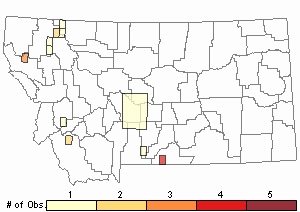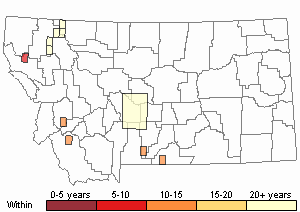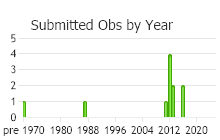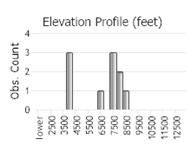View in other NatureServe Network Field Guides
NatureServe
Montana
Utah
Wyoming
Idaho
Wisconsin
British Columbia
South Carolina
Yukon
California
New York
Bog Haircap Moss - Polytrichum strictum
Other Names:
Hummock Haircap
General Description
Plants: Acrocarpous (Vitt 1988), growing in thick, crowded clumps of upright shoots and developing from a subterranean rhizome, green, or green with a whitish cast, eventually becoming deep brown (FNA 2007). Stems occasionally branched (Lawton 1971), mostly 6-12 cm tall, obscured with an interwoven, woolly, pale brown to white covering of rhizoids (FNA 2007) which are noticeable amongst the leaves (Lawton 1971).
Leaves: Overlapping and pressed flat against or loosely near to the stem when dry, spreading a little when wet (FNA 2007), 3-5 mm in length (Lawton 1971), consisting of a blade (limb) above a clasping sheath (FNA 2007); sheath somewhat yellow (Lawton 1971), suddenly constricted at the sheath/blade juncture, the sheath margins transparent; blade plane and slender, lance-shaped and narrowing to form an acumen; blade margins transparent, smooth or shallowly and finely scalloped, curved inward abruptly and enveloping the lamellae (rib-like flaps or walls of cells running longitudinally along the ventral blade surface), the margins overlapping each other near the leaf tip (FNA 2007); lamellae 25-30, seldom to 35 (Lawton 1971), green, nearly covering the blade (Crum and Anderson et al. 1981); costa extending slightly beyond the leaf tip, forming a short brownish awn, with teeth on the outside of the leaf near the apex (FNA 2007) and on the awn (Lawton 1971).
Leaf Cells: Lamellae 5-8 cells tall, looking shallowly scalloped in profile, in X-section the topmost (“marginal” or “terminal”) cells of the lamellae pear-shaped and thick-walled, with a bulge on top, the cells of the lamella closest to either leaf margin egg-shaped and not thickened on top; margin of the lamina of 1 cell-layer and 6-7 cells in width, the cells lengthened crosswise, and slightly slanted relative to the margins, hyaline; sheath cells oblong and somewhat long, wider further in from the margin (FNA 2007).
Diagnostic Characteristics
The similar Polytrichum juniperinum resides in mineral soil rather than organic soil as with Polytrichum strictum, and has brown woolly rhizoids restricted to the base rather than whitish tomentum all over the stem (Vitt 1988; Lawton 1971).
Range Comments
North American Range
AK to NT, BC to NL and NS, WA to CA, UT, MT to CO, MN and IA e and ne to the coast, also GA and NC (FNA 2007). Known in Montana from Beaverhead, Carbon, Flathead, Gallatin, Glacier, and Sanders Counties (Elliott and Pipp 2016).
Observations in Montana Natural Heritage Program Database
Number of Observations: 20
(Click on the following maps and charts to see full sized version)
Map Help and Descriptions
Relative Density

Recency



 (Observations spanning multiple months or years are excluded from time charts)
(Observations spanning multiple months or years are excluded from time charts)
Habitat
Organic soil and peat in wetlands and alpine tundra (Elliott and Pipp 2016). Occurring from low elevations to about 7870 feet (Lawton 1971).
Ecology
Polytrichum strictum frequently grows individually on hillocks of Sphagnum, signaling the driest spots of the hillock (Vitt 1988).
Reproductive Characteristics
Dioicous. Periogonial bracts wide and overlapping, forming noticeable rosettes. Perichaetial bracts slenderly awned. Seta russet or somewhat yellow, 20-40 mm tall. Capsule nearly cubic or slightly lengthened with the 4 angles sharp, 2-3 mm in length, just shy of vertical, becoming level when mature; peristome with 64 teeth. Calyptra pale brown to a soiled white, thickly covered with intertwined hairs, encompassing the entire capsule (FNA 2007).
Stewardship Responsibility
References
- Literature Cited AboveLegend:
 View Online Publication
View Online Publication Crum, H.A. and L.E. Anderson. 1981. Mosses of Eastern North America. 2 volumes. Columbia University Press, New York. 1328 pp.
Crum, H.A. and L.E. Anderson. 1981. Mosses of Eastern North America. 2 volumes. Columbia University Press, New York. 1328 pp. Elliott, J.C. and A.K. Pipp. 2018. A Checklist of Montana Mosses (1880-2018). Updated 3 January, 2020. Montana Natural Heritage Program, Helena, Montana. 73 pp.
Elliott, J.C. and A.K. Pipp. 2018. A Checklist of Montana Mosses (1880-2018). Updated 3 January, 2020. Montana Natural Heritage Program, Helena, Montana. 73 pp. Flora of North America Editorial Committee, eds. 2007. Flora of North America North of Mexico. Volume 27. Bryophytes: Mosses, Part 1. Oxford University Press, Inc., NY. xxi + 713 pp.
Flora of North America Editorial Committee, eds. 2007. Flora of North America North of Mexico. Volume 27. Bryophytes: Mosses, Part 1. Oxford University Press, Inc., NY. xxi + 713 pp. Lawton, E. 1971. Moss Flora of the Pacific Northwest. Hattori Botanical Laboratory. Japan: Yamabuki-cho, Shinjuku-ku, Tokyo. 362 pages plus appendices.
Lawton, E. 1971. Moss Flora of the Pacific Northwest. Hattori Botanical Laboratory. Japan: Yamabuki-cho, Shinjuku-ku, Tokyo. 362 pages plus appendices. Vitt, D. J. Marsh, and R. Bovey. 1988. Mosses, Lichens & Ferns of Northwest North America. Seattle, WA: University of Washington Press. 296 p.
Vitt, D. J. Marsh, and R. Bovey. 1988. Mosses, Lichens & Ferns of Northwest North America. Seattle, WA: University of Washington Press. 296 p.
- Additional ReferencesLegend:
 View Online Publication
View Online Publication
Do you know of a citation we're missing? Elliot, J. C. 1993. Second checklist of Montana mosses. Unpublished report. U.S. Forest Service, Region 1. Missoula, MT. 45 pp.
Elliot, J. C. 1993. Second checklist of Montana mosses. Unpublished report. U.S. Forest Service, Region 1. Missoula, MT. 45 pp. Lawton, E. 1971. Keys for the Identification of the Mosses on the Pacific Northwest. Reprinted from 'Moss Flora of the Pacific Northwest'. Published as Supplement No. 2 of the Journal of the Hattori Botanical Laboratory. Nichinan, Miyazaki, Japan. 66 pp.
Lawton, E. 1971. Keys for the Identification of the Mosses on the Pacific Northwest. Reprinted from 'Moss Flora of the Pacific Northwest'. Published as Supplement No. 2 of the Journal of the Hattori Botanical Laboratory. Nichinan, Miyazaki, Japan. 66 pp.
- Web Search Engines for Articles on "Bog Haircap Moss"





